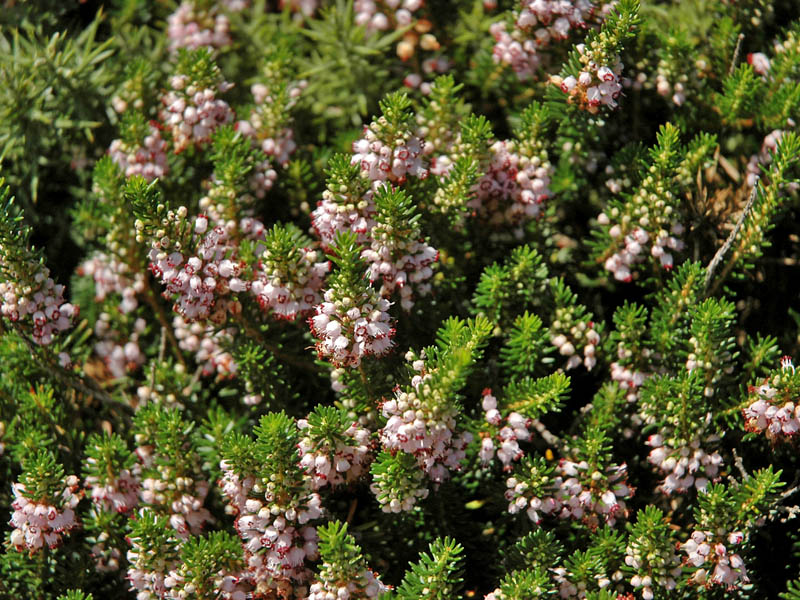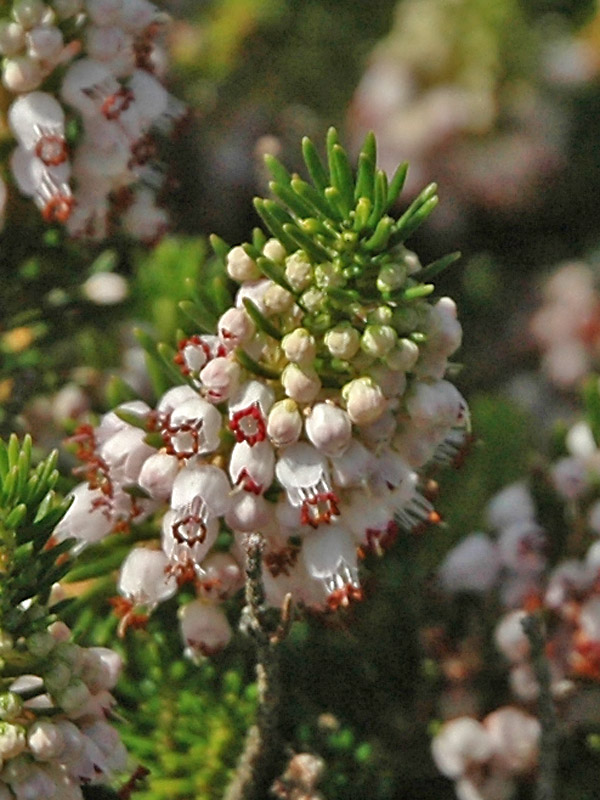
Woody > Erica > Erica vagans > Erica vagans
Erica vagans
Cornish Heath
Origin: Listed as an endangered and protected species, Erica vagans inhabits scant locales on Spain's north coast, the Pyrenees, Northern Ireland, and the Lizard Peninsula in Britain. It is interesting to note that the shrub has actually become naturalized in northern California, Oregon, Pennsylvania, Massachusetts, New Zealand, Switzerland, and Madeira by breaking free of private gardens. Erica vagans was once called the 'Fire-leaved heath, with many flowers' by English botanist and naturalist John Ray in 1670. Carl Linnaeus named the shrub Erica vagans in 1770.
Mike's
Opinion


"
Erica vagans is a low, spreading evergreen shrub and one of the best of the late flowering heaths.
Michael Pascoe, NDP., ODH., CLT., MSc. (Plant Conservation)
"
| Family |
| Ericaceae |
| Genus |
| Erica |
| Species |
| vagans |
| Category |
| Woody |
| Type |
| Shrub (evergreen) |
| Pronunciation |
| USDA Hardiness Zone |
| 5 - 7 |
| Canadian Hardiness Zone |
| 6 - 8 |
| RHS Hardiness Zone |
| H6 |
| Temperature (°C) |
| -29 |
| Temperature (°F) |
| -20 |
| Height |
| 30 - 60 cm |
| Spread |
| 30 - 60 cm |
Photographs
Description and Growing Information
Flowering Period
| General Description |
| Erica vagans is a low, spreading evergreen shrub. The branches are either erect or decumbent and have whorled, dark green, needle-like leaves. There are many flower umbels of white, lavender, mauve, or pink forming impressive floral spikes. |
| Landscape |
| Erica vagans is best planted as it grows in the wild - as ground cover, and in drifts forming mats of colour. The shrub adds late summer and autumn interest; blooming in shades of pure white, rich pink, and pale lilac. Erica vagans naturalizes beautifully as it is long lived, readily escapes gardens, and performs well in woodlands of pine and oak. This being said, the shrub does prefer a more open habitat and may fail to bloom if the shade is too heavy. |
| Cultivation |
| Soil must be light, friable, sandy, and well drained. If you are cursed with a waterlogged soil or high water table, the shrub should be planted in a raised bed. Erica vagans does not require an acid soil with a low pH. In fact, it can flourish in calcareous soil with a pH higher than 8, but will most likely remain smaller and not flower as well. An annual application of mulch with rotted leaf mould, shredded bark, and peat moss should be applied. Erica vagans prefers an open, sunny location. This being said, the shrub will tolerate an open, woodland locale as well. Erica vagans can readily regenerate after fire, cold, or grazing damage. However, it is probably best to provide some protection in colder climes to prevent excessive winter dieback. |
| Shape |
| Low, spreading |
| Growth |
| Medium |
| ID Characteristic |
| Erica vagans shares morphological similarities with Erica multiflora and Erica manipuliflora making it difficult to tell them apart. However, there are distinguishing features: the anthers of Erica vagans are tiny at a mere 0.5 mm long, and the two thecae that make up each anther are clearly separate and divergent. The easiest way to distinguish the shrub - where it naturally grows. Only Erica vagans grows from Galicia to Cornwall with a small population in northwest Ireland; it does not share its range with any other species of Erica. |
| Pests |
| Erica vagans is a relatively pest and disease free evergreen shrub. Gall midges can cause poorly formed shoots, and some soil borne fungi can be problematic. Simply prune out and destroy any affected part of the shrub. |
| Habitat |
| It inhabits heathland, moors, pine and oak woodlands and coastal dunes. |
| Bark/Stem Description |
| Twigs of the current season are green, glabrous, and ridged from decurrent leaf bases. Older twigs are light brown in colour, glabrous, and rough from raised leaf scars. The bark of a fully grown shrub is thin and smooth. |
| Flower/Leaf Bud Description |
| The buds of Erica vagans are small, sessile, and globose with three or more scales overlapping like shingles. |
| Leaf Description |
| Erica vagans has dark green, needle-like leaves. Held in whorls of 4 or 5, they are linear, 10 mm long, and approximately 1 mm wide. They are also glabrous, except for microscopic spicules at the tip. The petiole sports short, simple hairs and is flattened above; margins are re-curved and convex underneath. Leaf edges have tiny spicules and the sulcus is closed and linear. |
| Flower Description |
| The inflorescences are axillary. Each umbel consists of 1 - 8 flowers of white, lavender, or pink on short lateral shoots. The peduncle is 8 mm long, glabrous, slender, and equal in diametre throughout. The bract is 1 mm long and near the base; bracteoles are close to bract and are small, triangular, and lanceolate. Unequally four lobed, the calyx is 1.3 mm long, glabrous, and has small hairs on the margins. The corolla is campanulate and 3 - 5 mm long; lobes are 1 - 1.5 mm long, erect and glabrous. There are 8 emergent stamens and the filaments are 4 mm long, straight, and slender. Dark and muticous, the anthers are 0.5 mm long, erect, separate, and diverging at the apex. The style is 4mm long, erect, and slender; stigma is 0.2 mm in diametre and is green or pink. Pear-shaped, the ovary is 1.5 mm tall and 1 mm in diametre with 8 ovules per locule. The nectary is dark, lobed, and surrounds the ovary stipe. |
| Fruit Description |
| The seed capsules of all northern Erica species are brown, 1 - 2 mm long, hairy, and dehisce loculicidally. Capsule walls are thin and papery when ripe, disintegrating when gently rubbed. The seed itself is 0.4 - 0.65 x 0.5 mm, ellipsoid, and finely pitted. |
| Colour Description |
| Flower colour of Erica vagans is variable with the corolla appearing in shades of lavender, mauve, pink, and white. In the winter, flowers become a lovely russet brown colour. Bark is green and glabrous in youth, becoming light brown with age. Leaves are dark green and remain unchanged throughout the season. Fruit is a brown, dehiscent capsule. |
| Texture Description |
| Erica vagans could be considered a fine to medium textured shrub. The fine texture comes from the soft, glabrous leaves and smooth flowers. However the ridged young stems and rough adult stems lends more of a medium texture. |
| Notable Specimens |
| County Fermanagh at Carrickbrawn, Northern Ireland. The Lizard Peninsula, Cornwall, England. |
| Propagation |
| When sowing always use fresh seeds, do not bury, and do so immediately. The soil should be a mix of lime free compost with an equal amount of lime free sand and grit. Use seed trays that are 7.5 - 10 cm deep and fill with a layer of fine gravel 0.5 cm deep. Proceed with a layer of grit 1 cm deep and then the soil mix. Wet the soil, preferably with rainwater, and drain. Sow the seeds evenly by mixing them with dry silver sand. Place the tray on a capillary mat or in a shallow tray with gravel. Be careful to not let the compost dry out or become too waterlogged. Make sure to mist or spray the soil surface twice a day. Erica vagans� seeds may take many weeks, months, or even a year to germinate. Once germination has occurred, allow the seedlings to stay in the tray for three months until large enough to handle and be put into their own pots. Erica vagans can also be propagated via cuttings, layering, and dropping. Dropping is a process where a dormant plant is dug up, re-planted into a larger and deeper hole, and partially covered with a soil mix. When the stem tips develop roots, they are severed from the parent and planted out. |
| Ethnobotanical Uses (Disclaimer) |
| Erica vagans is used as kindling, brooms, and animal feed and bedding. It is also an important source of honey in Spain and France. |
References
Nelson, Charles E. ,Hardy Heathers From The Northern Hemisphere: Calluna - Daboecia - Erica. Richmond, Surrey: Kew Publishing, 2011. Print.
Mikolajski, Andrew. 'Heathers'. Blaby Road, Wigston, Leicestershire: Anness Publishing, 2013. Print.

